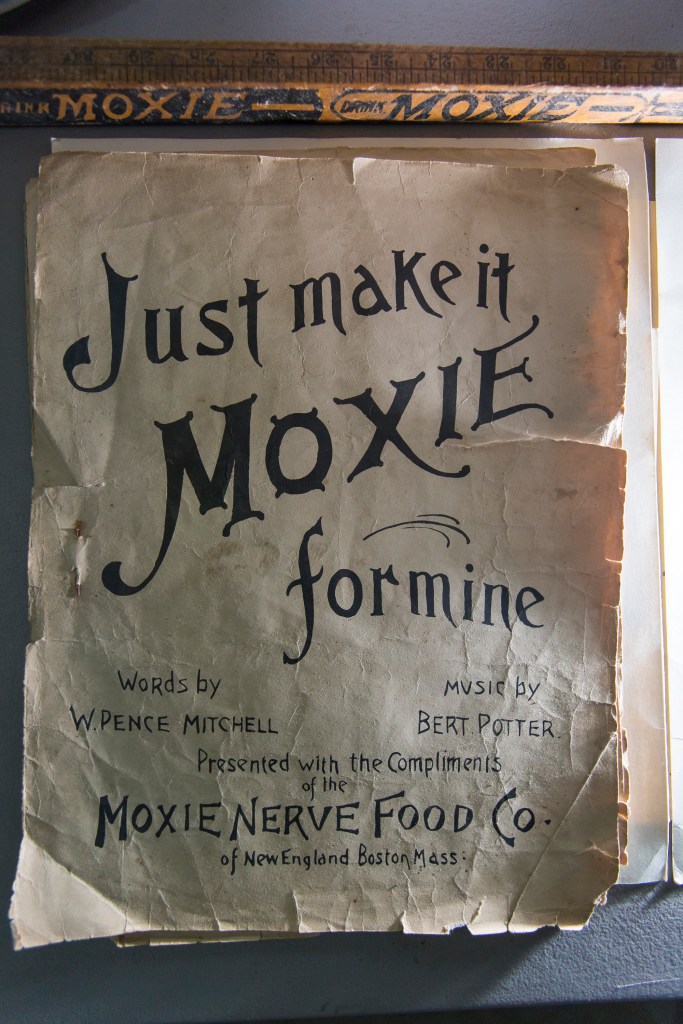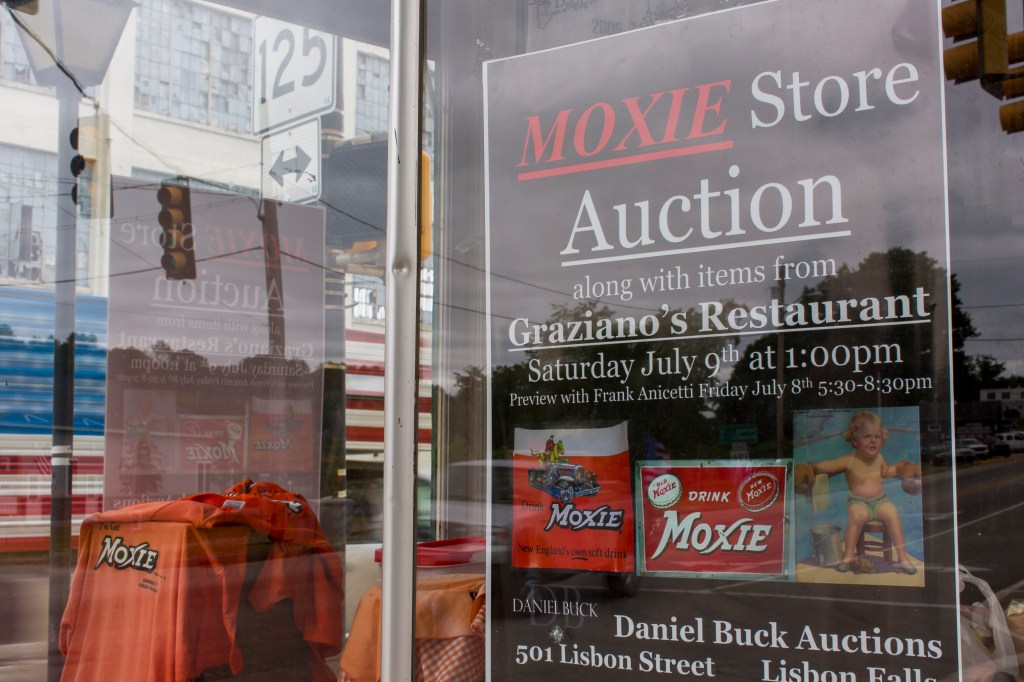LISBON — How much moxie does Frank Anicetti have?
More than 34 years ago he had enough moxie – as in umph or gumption – to convince the people of Lisbon that they should host an annual festival to celebrate the unique flavor and long history of the soft drink called Moxie, invented in 1876 by Dr. Augustin Thompson of Union, Maine. This weekend, the annual Moxie Festival likely will draw 50,000 people to the former textile mill town.
But Anicetti has still more Moxie to share. On Saturday at 1 p.m., his Moxie collection will be auctioned off. It contains a hundred or so items – posters, calendars, thermometers, signs, pennants, buttons, aprons, bumper stickers, sheet music for songs about Moxie and even a full, 1890 bottle of “Moxie Nerve Food.”
Anicetti has Moxie memorabilia to spare because, in February, he closed his family’s 103-year-old Main Street store, Kennebec’s, known to most people as The Moxie Store. After helping to start the Moxie Festival, Anicetti became the keeper of all things Moxie, including items donated to him and lots of new Moxie merchandise he sold proudly. But the 76-year-old has decided to retire and is selling the store. Besides Moxie collectibles, the auction Saturday will include soda fountain fixtures, malted mixers, old pop bottles, 100-year-old cash registers, can openers, candy scales and other pieces of small-town nostalgia.
To Moxie fans and people in Lisbon, the store’s closing is like Moxie itself: a little bitter and a little sweet. Most involved with the festival have no doubt that it will continue long after Anicetti’s last bottle of vintage Moxie is sold, but it won’t be quite the same without The Moxie Store.
“He paved the way for the growth of the festival, he made this available to the next generation,” said Tracey Steuber, the festival coordinator. “Other stores will sell Moxie merchandise, the festival will go on, but certainly people will remember what that store has meant.”
As for Anicetti, he plans to “take it easy” in retirement, maybe travel a little and sit in on some lectures at Bates College in nearby Lewiston. His grandfather, Lamberto Anicetti, immigrated from Italy in 1909 and started the store in 1913, when the giant Worumbo textile mill across the street was humming day and night and providing a good living to the townspeople. Anicetti’s father ran the store, long called Kennebec Fruit Company, for a while and passed it along to him.
The two-story, wood-frame building now has peeling paint and has seen better days. It stands across the street from the soon-to-be-demolished mill complex, with its faded facade and broken windows. The asking price for the store building is $99,000.
When Anicetti was young, the store would be open from 6 a.m. past midnight. Workers on all shifts could get an ice cream, soda or some grocery item on the way home.
“I remember buying penny candy, and we’d drive (Anicetti’s) parents and grandparents crazy because we’d want four of these, and two of those, and one of these,” said Faye Brown, 69, a life-long resident and owner of Faye’s Barber Shop. “Then Frank took over, and he became a big Moxie aficionado, and things just escalated from there.”
Anicetti sold Moxie in his store, of course, and liked to drink it. But his fascination with it began when a Lewiston-based distributor of Moxie called him and asked if he wanted to see a “toy” he had in his warehouse. It was a 1923-vintage Moxie mobile of sorts, an aluminum horse mounted to a car chassis, used by local Moxie distributors in parades or at various events. The odd piece of Moxie history piqued Anicetti’s interest in the history of the soft drink, which although invented by a Mainer, was never made in Maine. (It was made for a long time in Massachusetts, and the company is now based in Bedford, New Hampshire.)
Anicetti’s research included little items, like the fact that the word “moxie” derives from an Native American word meaning “dark water.” Moxie the soft drink is dark, as are the waters of Moxie Pond in northern Maine.
His research led him to a relationship with author Frank Potter, who wrote a history of Moxie called “The Moxie Mystique” in 1981. Anicetti had a book-signing event for Potter at his store. That event morphed into the festival.
“We thought maybe 50 people would show up, but we got 500,” Anicetti said. “People love Moxie.”
The man who will auction off Anicetti’s collection, Daniel Buck Soules, said some of the items might draw bids of more than $1,000, while many items, like old ice cream scoopers, likely will sell for $5 to $10. He expects the auction, which also includes items from the former Graziano’s restaurant in Lisbon, to last about two and a half hours. Everything will be sold. The auction will take place at Daniel Buck Auctions on Lisbon Street, about a mile from where Anicetti’s store was.
The Moxie Festival, which started Friday, is a three-day celebration of Moxie soda and of the moxie exhibited by the people of Lisbon. People all over town work to put on the turkey supper, the road race, the fireworks display, the two-hour parade, the car show, concerts, the Moxie chugging contest, the Moxie Congress and all the other events. The festival has become one of southern Maine’s signature summer events, right up there with the Yarmouth Clam Festival.
It’s such an important event to the town that the festival coordinator, Steuber, is also the town’s economic development director.
On Friday, as bright orange Moxie Festival banners fluttered from telephone poles along Lisbon Street, Moxie fans in orange T-shirts trickled into town. (Orange is the color of the Moxie label, you might have guessed.)
One of them, James Jansson of Shelton, Connecticut, came to the Daniel Buck Auctions basement to see some of Anicetti’s collection. He comes to the festival every year to portray “The Moxie Boy,” the white-coated soda fountain attendant used in early Moxie advertising.
“I’ve always thought if something happened to Frank’s store, it just wouldn’t be the same,” Jansson said. “His store was the focal point for 34 years, so we’ll see what happens now.”
Send questions/comments to the editors.









